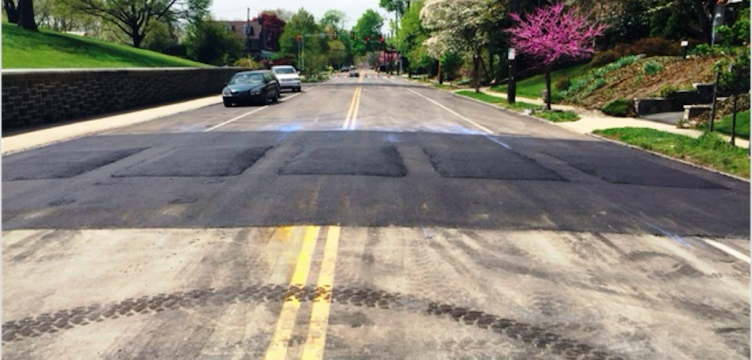
Image: PlanPhilly
Editor’s note: As cyclists, we understand there are some people who don’t like us, no matter what. Maybe they had a bad experience with a person on a bike at some point, maybe they don’t think we belong on the roads. Whatever the case, those people send me emails and comments based on stuff I write on our blog, and in my column in Metro Philadelphia. In the hopes (false hopes, most likely) that I never have to answer the same question twice, I write this regular feature on this blog answering your FAQs. If you want me to answer one of yours, please send me a non-explicit email to randy@bicyclecoalition.org.
Someone named “Mike,” who commented on one of our blogs recently, does not like traffic calming devices.
In his comment, he wrote, “Speed bumps damage vehicles, cause crashes, and delay EMS.”
The only remotely reasonable part of this comment is the “Delay EMS” one. That’s because there are some comments online from people who’ve made these claims. And unlike claims that protected bike lanes would delay emergency vehicles, the claims I found were made by officials within the EMS field, not anonymous flier writers.
The first hit on Google when you look for “speed humps delay ems” is a story from EMS1.com, a trade website about emergency responders.
The article points to an anecdotal claim from a Durham, North Carolina fire official, who believed a response was delayed because emergency vehicles had to drive over a speed hump.
A similar claim was made by a South Carolina EMS official.
But OK. Anyone can claim anything. To check out what the deal is, I went over to the National Association of City Transportation Officials’ work on the subject.
Thing about speed cushions and humps is that there are recommended versions, and they’re not the ones you see and feel in the movie theater parking lot. Recommended speed humps (like, for instance, the ones recently installed on Second Street in Northern Liberties) are specifically designed for emergency vehicles with a wider wheel base than passenger cars, to “pass unimpeded while slowing most traffic.”
Check out this photo of a properly designed speed hump.

Image via NACTO
NACTO also recommends, before installing speed humps (and we agree…):
- Seek approval by emergency response officials for treatments on emergency response routes.
- Allow a limited set of emergency vehicle-friendly traffic calming techniques on emergency response routes.
- Estimate travel time impacts on emergency vehicle response time and define goals to evaluate during a trial.
- Implement speed management treatments on a trial basis and work with emergency response officials to determine whether permanent features are appropriate.
The Philadelphia Streets Department has also accounted for many of the FAQs people have about speed cushions.
There you have it. What speed humps may have done in the past has been accounted for with more recent designs.
There will be not be a reader response next week as I will be out of the office. But look for one July 28!

This only comments on half the problem, in your above example you easily show a firetruck navigating successfully over a calming device, yet has a study ever been done on traffic in FRONT of an emergency vehicle slowly negotiating calming devices which in turn slows the response time of the emergency vehicle which is behind the traffic? Now we both understand that vehicles are to move out of the way but we have both witnessed confusion when it comes to the average driver trying to move their car over with a lot of other cars in the road.
Randy, thank you for this well thought out response. I frequently don’t have the patience to respond to those standing in the way of Vision Zero (http://www.visionzerophl.com/) so I applaud your tenacity in defending the community’s efforts to improve and progress.